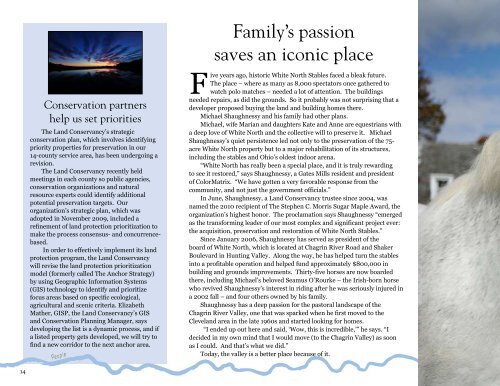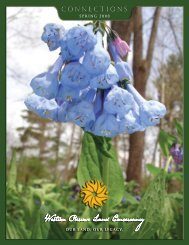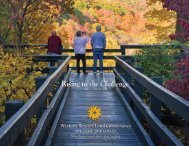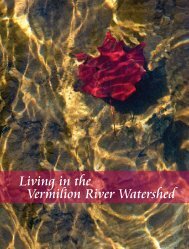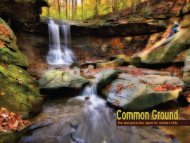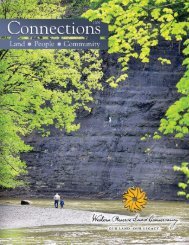2010 Donor Report - Western Reserve Land Conservancy
2010 Donor Report - Western Reserve Land Conservancy
2010 Donor Report - Western Reserve Land Conservancy
You also want an ePaper? Increase the reach of your titles
YUMPU automatically turns print PDFs into web optimized ePapers that Google loves.
Family’s passion<br />
saves an iconic place<br />
Conservation partners<br />
help us set priorities<br />
The <strong>Land</strong> <strong>Conservancy</strong>’s strategic<br />
conservation plan, which involves identifying<br />
priority properties for preservation in our<br />
14-county service area, has been undergoing a<br />
revision.<br />
The <strong>Land</strong> <strong>Conservancy</strong> recently held<br />
meetings in each county so public agencies,<br />
conservation organizations and natural<br />
resource experts could identify additional<br />
potential preservation targets. Our<br />
organization’s strategic plan, which was<br />
adopted in November 2009, included a<br />
refinement of land protection prioritization to<br />
make the process consensus- and concurrencebased.<br />
In order to effectively implement its land<br />
protection program, the <strong>Land</strong> <strong>Conservancy</strong><br />
will revise the land protection prioritization<br />
model (formerly called The Anchor Strategy)<br />
by using Geographic Information Systems<br />
(GIS) technology to identify and prioritize<br />
focus areas based on specific ecological,<br />
agricultural and scenic criteria. Elizabeth<br />
Mather, GISP, the <strong>Land</strong> <strong>Conservancy</strong>’s GIS<br />
and Conservation Planning Manager, says<br />
developing the list is a dynamic process, and if<br />
a listed property gets developed, we will try to<br />
find a new corridor to the next anchor area.<br />
Five years ago, historic White North Stables faced a bleak future.<br />
The place – where as many as 8,000 spectators once gathered to<br />
watch polo matches – needed a lot of attention. The buildings<br />
needed repairs, as did the grounds. So it probably was not surprising that a<br />
developer proposed buying the land and building homes there.<br />
Michael Shaughnessy and his family had other plans.<br />
Michael, wife Marian and daughters Kate and Anne are equestrians with<br />
a deep love of White North and the collective will to preserve it. Michael<br />
Shaughnessy’s quiet persistence led not only to the preservation of the 75-<br />
acre White North property but to a major rehabilitation of its structures,<br />
including the stables and Ohio’s oldest indoor arena.<br />
“White North has really been a special place, and it is truly rewarding<br />
to see it restored,” says Shaughnessy, a Gates Mills resident and president<br />
of ColorMatrix. “We have gotten a very favorable response from the<br />
community, and not just the government officials.”<br />
In June, Shaughnessy, a <strong>Land</strong> <strong>Conservancy</strong> trustee since 2004, was<br />
named the <strong>2010</strong> recipient of The Stephen C. Morris Sugar Maple Award, the<br />
organization’s highest honor. The proclamation says Shaughnessy “emerged<br />
as the transforming leader of our most complex and significant project ever:<br />
the acquisition, preservation and restoration of White North Stables.”<br />
Since January 2006, Shaughnessy has served as president of the<br />
board of White North, which is located at Chagrin River Road and Shaker<br />
Boulevard in Hunting Valley. Along the way, he has helped turn the stables<br />
into a profitable operation and helped fund approximately $800,000 in<br />
building and grounds improvements. Thirty-five horses are now boarded<br />
there, including Michael’s beloved Seamus O’Rourke – the Irish-born horse<br />
who revived Shaughnessy’s interest in riding after he was seriously injured in<br />
a 2002 fall – and four others owned by his family.<br />
Shaughnessy has a deep passion for the pastoral landscape of the<br />
Chagrin River Valley, one that was sparked when he first moved to the<br />
Cleveland area in the late 1960s and started looking for homes.<br />
“I ended up out here and said, ‘Wow, this is incredible,’” he says. “I<br />
decided in my own mind that I would move (to the Chagrin Valley) as soon<br />
as I could. And that’s what we did.”<br />
Today, the valley is a better place because of it.<br />
14


